Within the first few moments, Downtown Club has me feeling like Max Verstappen. Lined up on the grid, I flex my gloved fingers and grip the steering wheel. The countdown begins and my right hand finds the shift knob. Three. Two. One. And I’m ready to race.
After the first lap, a different Max springs to mind: my childhood friend’s Labrador retriever who was hit by a car. As it turns out, driving in Downtown Club is hard. At least, it’s hard at first.
An hour after my first horrendous lap, it’s all coming together. The engine sings as I apex a corner, passing a slower car on the inside. I sweep to a long straight that dips below an elevated city walk. The sun shines off the windows of the office towers to the left and right. The sky is blue. The clouds are fluffy. Suddenly, I’m in heaven— albeit a very limited, Early Access heaven.
What is it?: An Early Access racing game with both thumbstick controls and full virtual controls.
Platforms: Meta Quest (Review conducted on Quest 2)
Release Date: Out now (Early Access)
Developer: Commuter Games
Price: $15.99
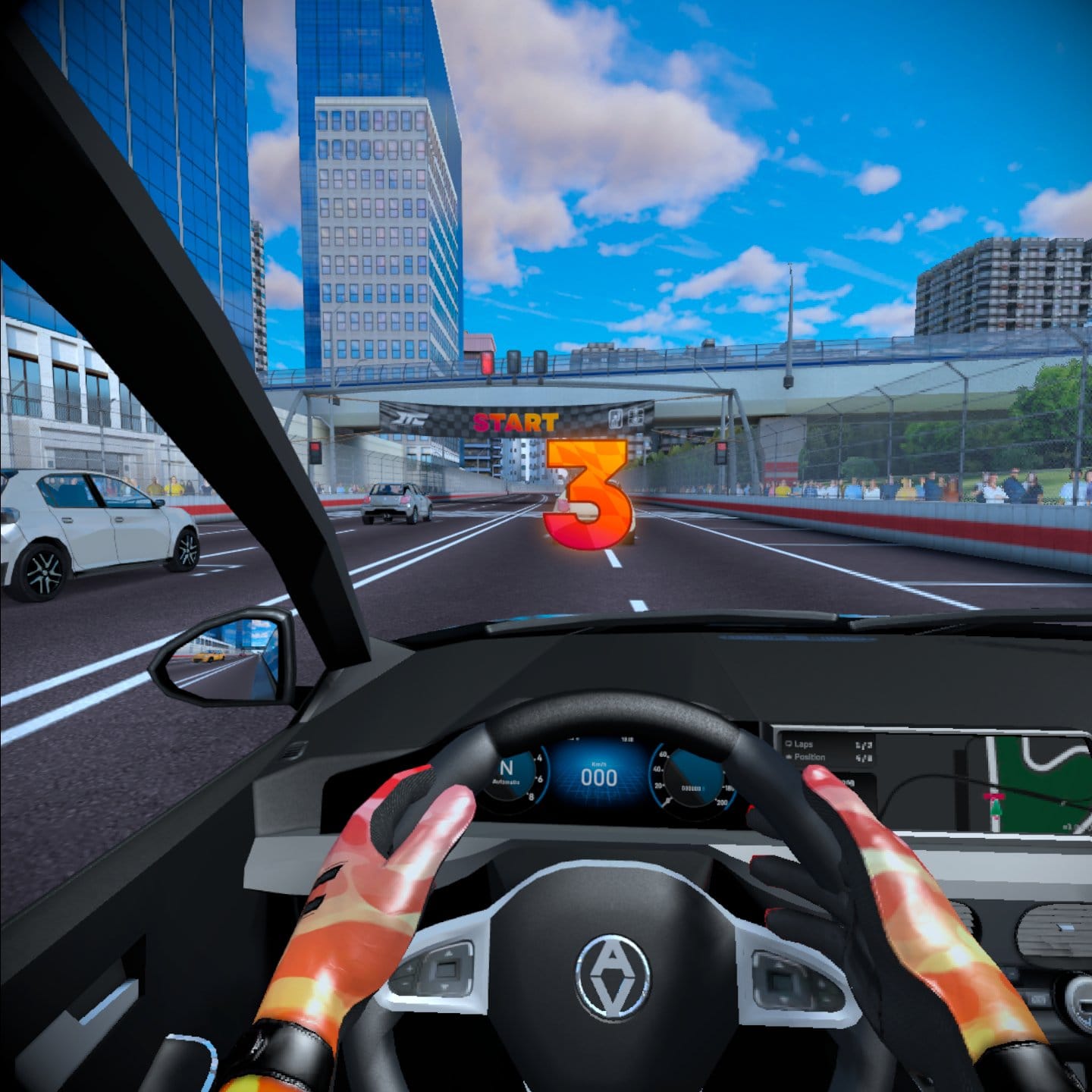
Downtown Club is a “simcade” racing game that offers both traditional thumbstick controls and full virtual controls. The latter control scheme allows you to interact directly with the major parts of the car. Our hands are on the wheel, the manual shifter, and the parking brake, and actuating any of these controls creates the sort of driving response we’d expect.
That’s the game’s big hook. Use your real-life hand to yank the virtual handbrake at 80 miles per hour and see what happens. In this way, Downtown Club succeeds in providing the simple, pure fun of direct, responsive user controls. While the experience does take some getting used to – gripping with the grip triggers and accelerating/braking with the index finger triggers require some cerebral flexibility. The end result is a smile and a thrill.
For moments when things become too hectic, releasing the steering wheel and using the analog stick automatically swaps to the more traditional thumbstick control scheme in real-time. While this saps a bit of the novelty, often the more traditional control methodology is more reliable and effective.
What’s impressive is how the game adapts to our desires without a stutter. Shifting from full virtual control to traditional control is literally seamless. It’s a fluid and dynamic system that does well to give the player whatever we want, whenever we want it.
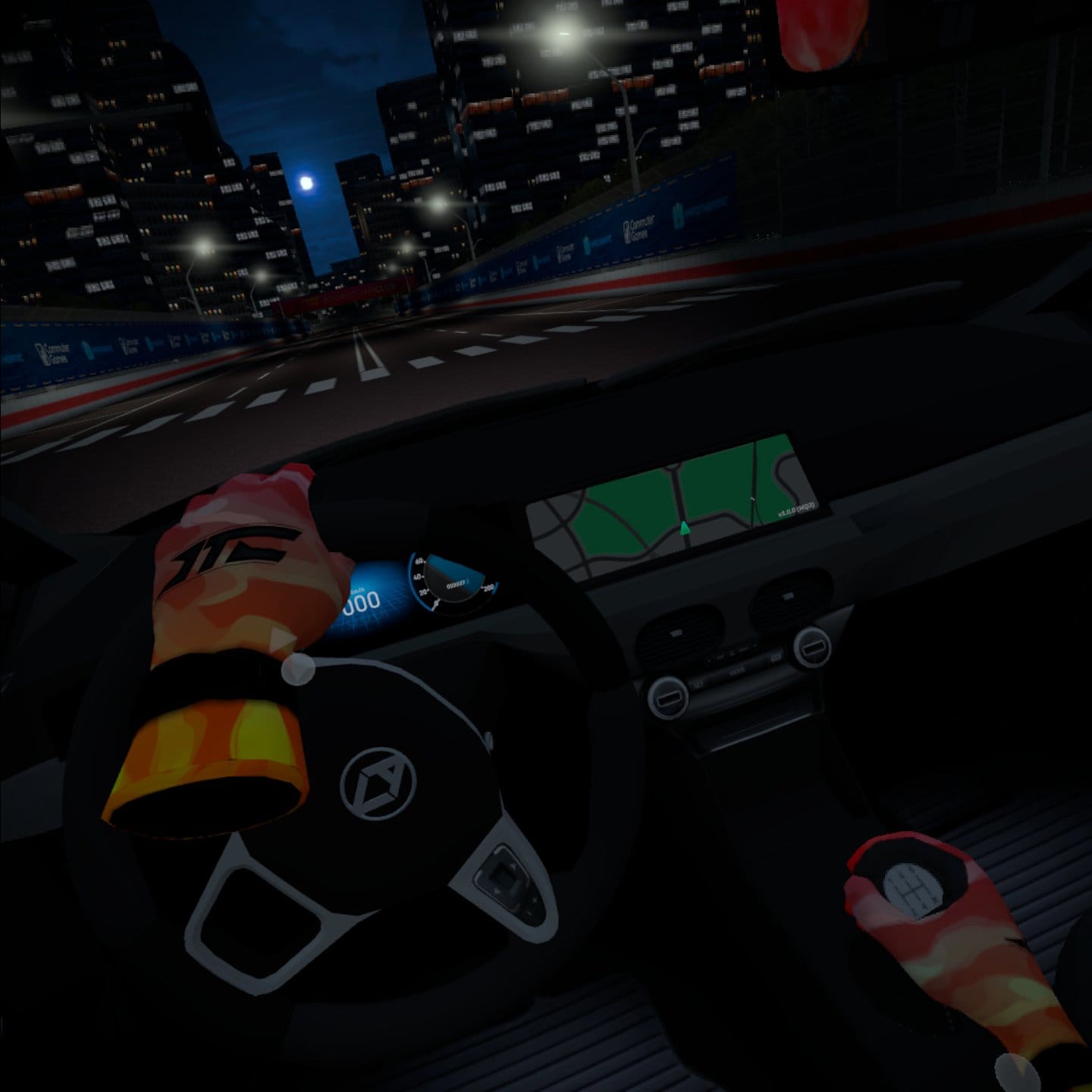
You can currently pick four game modes. Events are thematically organized competitions with numerous pre-arranged tracks; completing these earns experience points and currency to buy unlockables. Custom Races are customizable races with many parameters that the player controls. Time Attack lets us race for the best lap times, which are posted to online leaderboards. Finally, Free Drive lets us freely explore the game’s larger map, from which the smaller racetracks of other modes are pulled, at any time of day or night.
The graphics are lovely and the aesthetic is stunning. After finally achieving a podium finish in one of the game’s early Events, I launched into Free Drive mode to simply enjoy the city that Commuter Games has built.
In the daytime, the city looks like Mirror’s Edge, and at night it looks like Tokyo Xtreme Racer 2. Diving below the surface into the relative obscurity of the city’s subterranean tunnels, things become claustrophobic in the best of ways. I push my car through the sodium light, the undulating roadways snaking up and down and around blind bends until I’m on the bleeding edge of my ability.
I burst into the sunlight and drift up an on-ramp to the elevated freeway. I soar through the glittering canyons created by high-rise towers. The sense of freedom is palpable. I hit the gas and feel the thrill of speed.
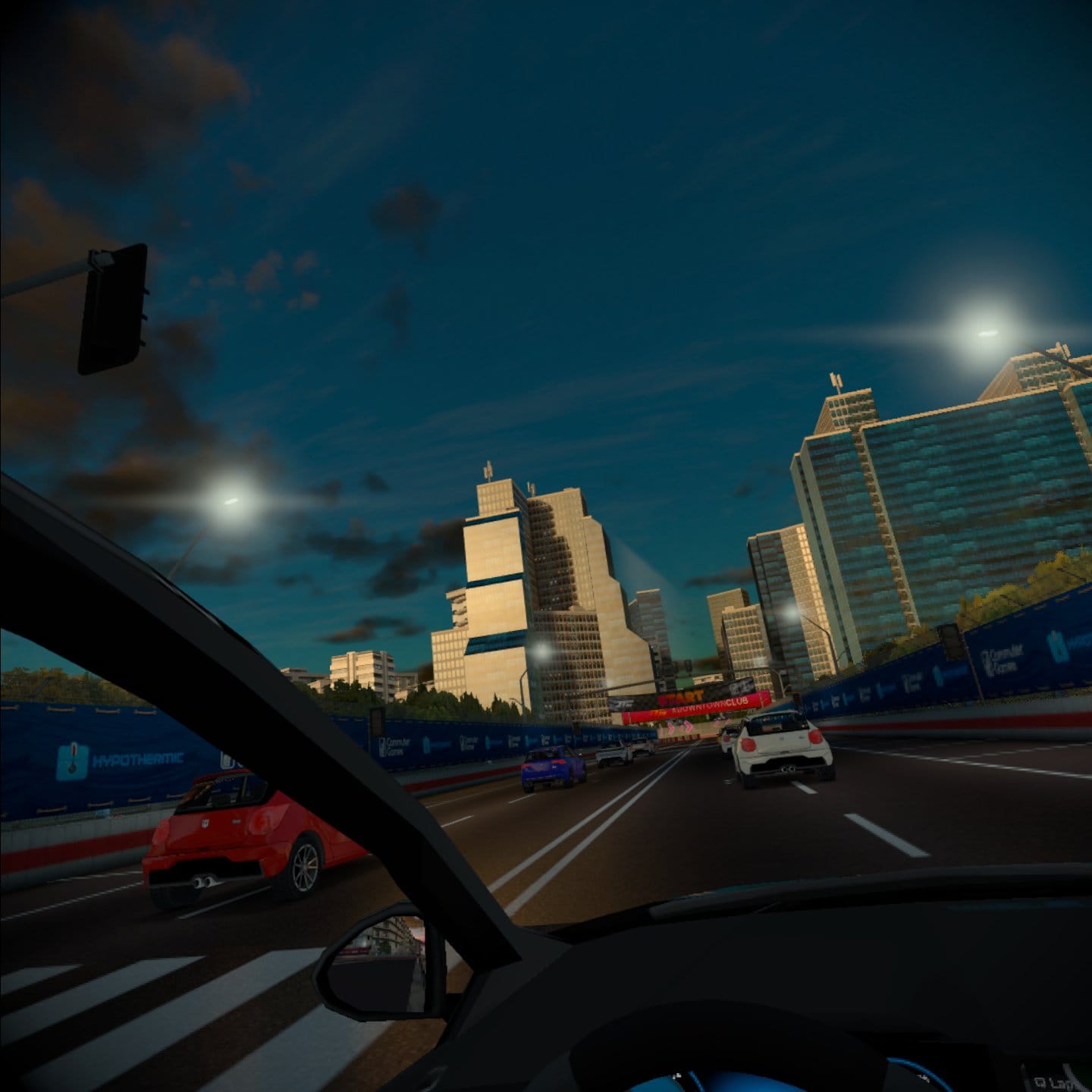
Downtown Club offers a suite of comfort controls including:
Player alignment: this is an anti-roll setting that can align the player’s perspective to the body of the car, to the road, or to a constant level determined by the VR boundary.
Collision attenuation: this setting causes the screen to turn black for a user-selectable duration after a crash against walls or other cars.
Vignette effect: also called “tunneling,” this setting blackens the edges of the player’s vision at high speed or when making extreme turns.
All of these comfort settings can be adjusted or turned off by the player.
Unfortunately, the game’s status as an Early Access release keeps hitting the brakes. The Free Drive mode feels sparse and depopulated, and the Event mode is limited. There’s only one major location, and the race tracks that spring from it are rather similar. You won’t currently find online play, and there are just three cars in the game, which are almost indistinguishable from one another.
The race music is awful. I’ve spent ten minutes trying to think of a way to explain it effectively, and I’m not sure that I can. It’s the sort of music that might exist if Shadow the Hedgehog started a punk rock band. It’s brutally repetitive, electric guitar trash.
In fairness, I have a long history of obsessing over racing games with all-timer soundtracks: the samba of Hiro Kawaguchi’s OutRun compositions, Richard Jacques’ euro beats from Metropolis Street Racer, and the airy city pop of Kazumi Totaka’s Wave Race 64. Granted, I can’t expect every game to sound as good as these, but Downtown Club needs better tunes.
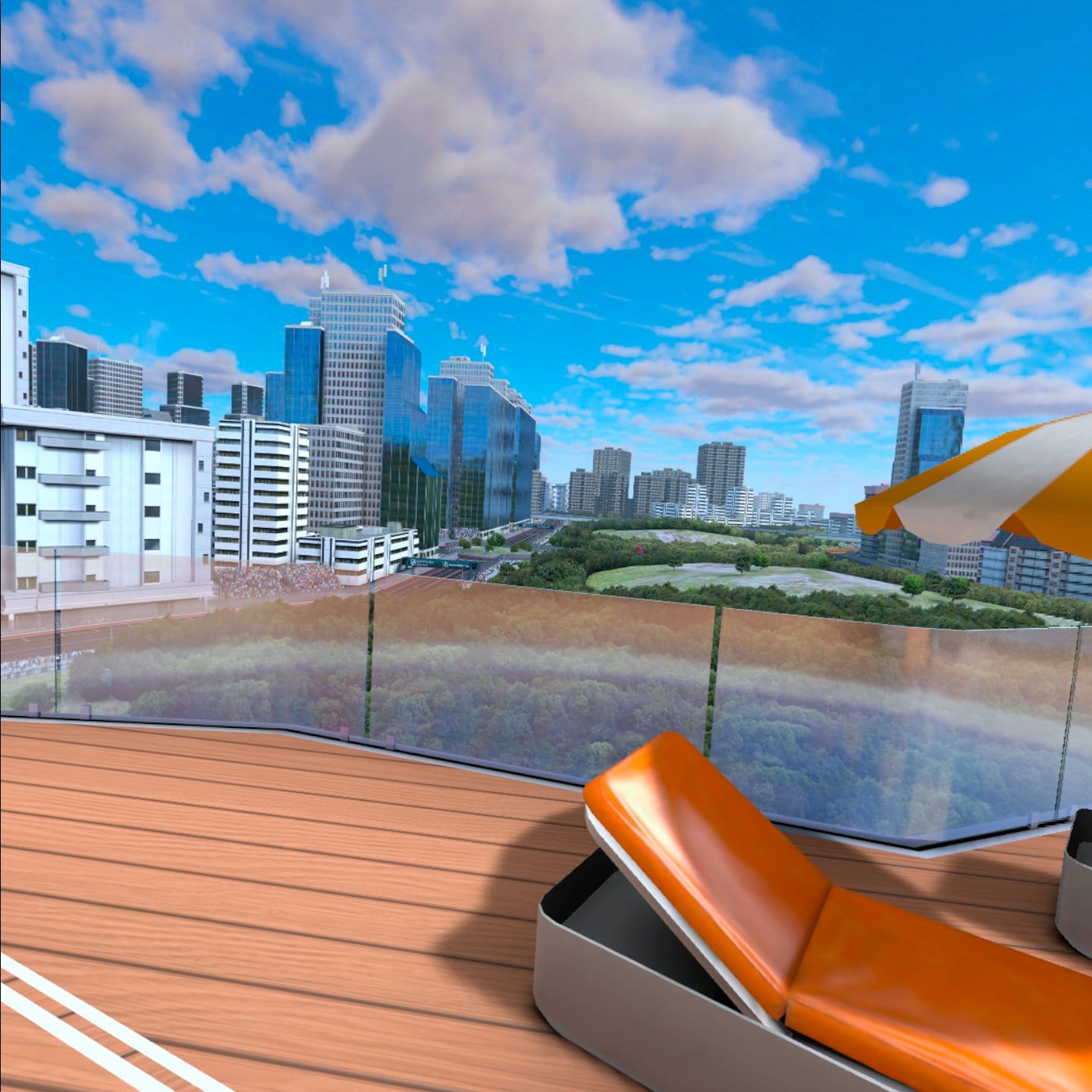
It also needs better AI. The opponents in Downtown Club are paradoxically chaotic and predictable at the same time. They adhere almost universally to a single racing line, running every race as if they were individual segments comprising some sort of hatchback monorail. Passing them is easy and takes no planning or technique. At the same time, being amongst them is fraught and frustrating since they have no regard for their lives or the lives of others. If you’re in their line, blocking them from being a part of their monorailic unit, they will simply smash through you.
Aggressive AI in racing games is fine, especially when your vehicle is equally planted and durable. But in Downtown Club, it’s not. Your car is a marshmallow and so are its tires, and when outbalanced aggression is the only strategy that the computer AI can employ, it gets old very quickly.
I also wish that the player cars were more interactive. I’d like radio controls, for example. It would be nice to adjust the music volume mid-race or switch between radio stations, assuming the developers produce a more varied soundtrack, or to switch the radio off entirely if they don’t. I imagine touching the infotainment system and using it as one does in a real car, adjusting the on-screen map, and planning a navigation route to guide me to where I want to go in Free Ride mode.
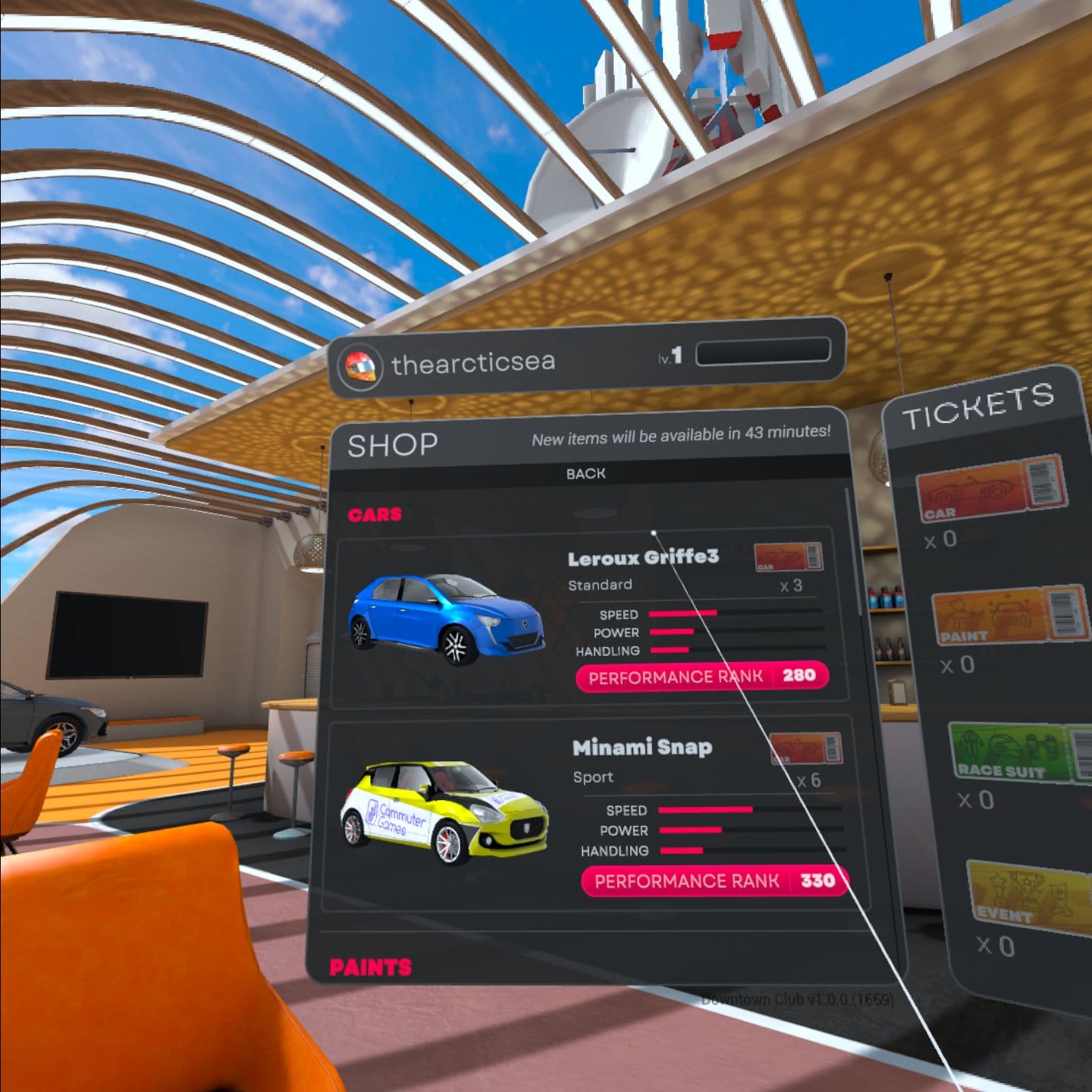
Downtown Club also needs more cars. Who has ever heard of a racing game with only three cars? Where are all the cars?! It needs more liveries, collectibles, maps, and online multiplayer.
But I shouldn’t complain too much. It’s an Early Access game, and if Commuter Games’ roadmap is to be believed, an upcoming free update will solve all of my complaints.
Downtown Club Review-In-Progress – Current Final Verdict
Downtown Club’s current version is extremely fun and engaging but while it has a lovely aesthetic and serious potential, presently, it’s just a bit sparse. The full release promises online multiplayer, multiplayer Free Ride, public lobbies, additional race modes, three waves of cars, and two waves of maps that sound varied and interesting. I have no reason to believe that these updates won’t happen, and when they do, Downtown Club will be a must-play experience.
UploadVR uses a 5-Star rating system for our game reviews – you can read a breakdown of each star rating in our review guidelines. As a review-in-progress, this is currently unscored to reflect our approach on covering post-launch updates. We’ll revisit this review once Downtown Club enters full release.
- SEO Powered Content & PR Distribution. Get Amplified Today.
- PlatoData.Network Vertical Generative Ai. Empower Yourself. Access Here.
- PlatoAiStream. Web3 Intelligence. Knowledge Amplified. Access Here.
- PlatoESG. Carbon, CleanTech, Energy, Environment, Solar, Waste Management. Access Here.
- PlatoHealth. Biotech and Clinical Trials Intelligence. Access Here.
- Source: https://www.uploadvr.com/downtown-club-review/



